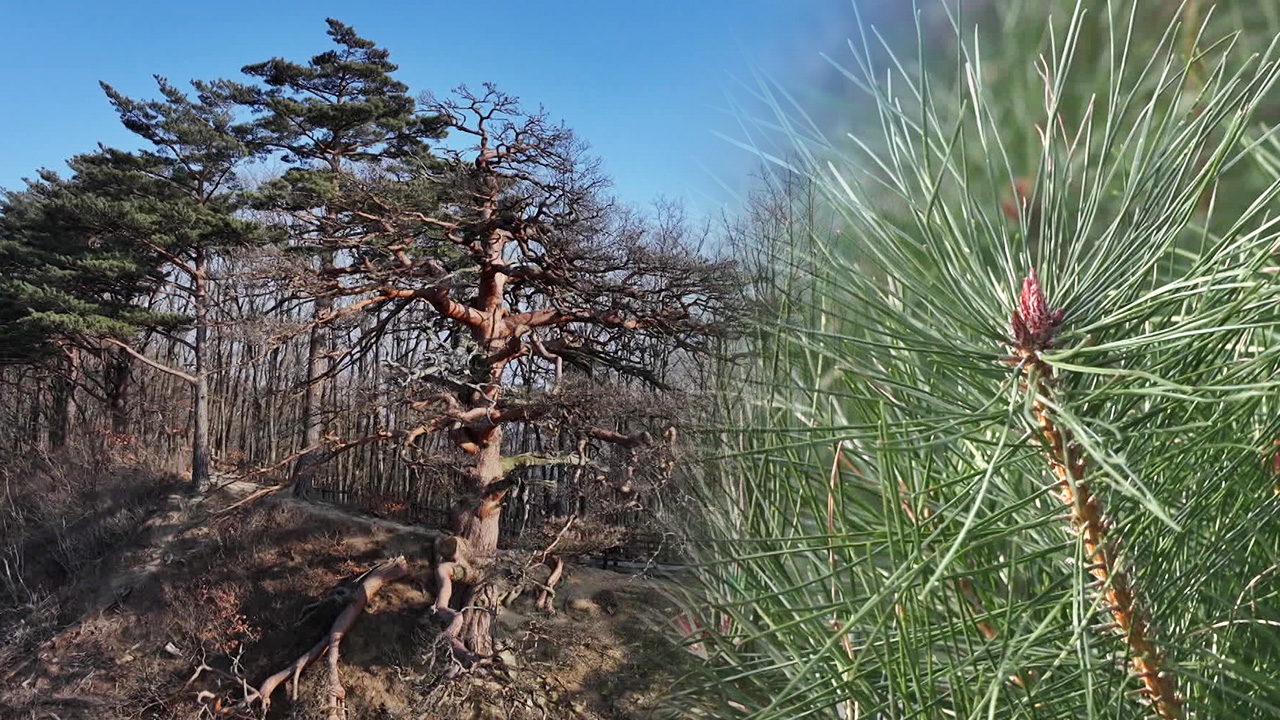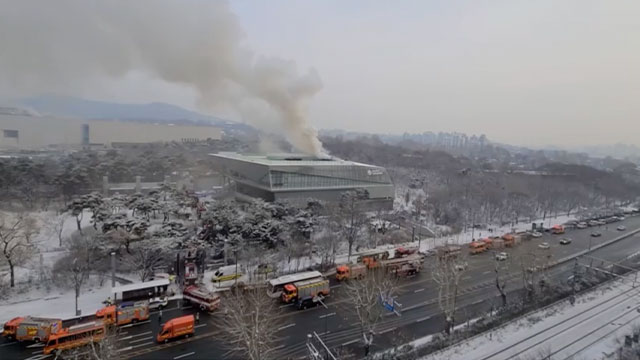[Anchor]
In the area of Uljin, where the largest cluster of Korean red pines is located, pine trees are dying in groups.
This began after the severe heatwave last summer, and even the 600-year-old 'Great King Pine' has ultimately perished.
Our meteorology specialist Lee Se-heum visited the site.
[Report]
The Korean red pines that stretch straight towards the sky form a massive forest in Uljin.
This cluster of Korean red pines has been protected by the royal family since the Joseon Dynasty due to its recognized value.
However, among the evergreen pines, white, dead trees are conspicuously visible.
This is the result of a mass die-off following last year's prolonged heatwave.
Even the 'Great King Pine', which had been under special management by the forestry authorities, could not escape death.
This is the 600-year-old Great King Pine of Uljin.
Since last summer, its branches have dried up, leaves have fallen, and this winter it was effectively declared dead.
[Seo Jae-cheol/Green Union Specialist: "Currently, not only is there a change in color fading, but it has already entered a stage where leaves are falling, so if we compare it to other living beings, it appears to be in a state where normal life processes have ceased..."]
The forestry authorities have identified climate stress, such as rising temperatures and weather anomalies, as the cause, rather than damage from pests and diseases.
As the age increases, the energy used for biological activities surpasses the nutrients obtained through photosynthesis, making older trees more vulnerable to high temperatures and lack of moisture.
Due to the characteristics of the preserved primeval forest, the presence of many older trees is accelerating the mass die-off.
[Lee Jin-soo/Forestry Agency Forest Environment Protection Officer: "In a survey conducted in 2022 targeting five areas in Uljin and Bonghwa, it was confirmed that about 6,000 trees had died."]
The Korea National Park Service predicts that if the current rate of climate change continues, about 40% of the pines in Taebaeksan National Park and half of those in Seoraksan will disappear.
The Forestry Agency has taken measures to preserve the genetics of the Korean red pine by planting successor trees.
This is KBS News, Lee Se-heum.
In the area of Uljin, where the largest cluster of Korean red pines is located, pine trees are dying in groups.
This began after the severe heatwave last summer, and even the 600-year-old 'Great King Pine' has ultimately perished.
Our meteorology specialist Lee Se-heum visited the site.
[Report]
The Korean red pines that stretch straight towards the sky form a massive forest in Uljin.
This cluster of Korean red pines has been protected by the royal family since the Joseon Dynasty due to its recognized value.
However, among the evergreen pines, white, dead trees are conspicuously visible.
This is the result of a mass die-off following last year's prolonged heatwave.
Even the 'Great King Pine', which had been under special management by the forestry authorities, could not escape death.
This is the 600-year-old Great King Pine of Uljin.
Since last summer, its branches have dried up, leaves have fallen, and this winter it was effectively declared dead.
[Seo Jae-cheol/Green Union Specialist: "Currently, not only is there a change in color fading, but it has already entered a stage where leaves are falling, so if we compare it to other living beings, it appears to be in a state where normal life processes have ceased..."]
The forestry authorities have identified climate stress, such as rising temperatures and weather anomalies, as the cause, rather than damage from pests and diseases.
As the age increases, the energy used for biological activities surpasses the nutrients obtained through photosynthesis, making older trees more vulnerable to high temperatures and lack of moisture.
Due to the characteristics of the preserved primeval forest, the presence of many older trees is accelerating the mass die-off.
[Lee Jin-soo/Forestry Agency Forest Environment Protection Officer: "In a survey conducted in 2022 targeting five areas in Uljin and Bonghwa, it was confirmed that about 6,000 trees had died."]
The Korea National Park Service predicts that if the current rate of climate change continues, about 40% of the pines in Taebaeksan National Park and half of those in Seoraksan will disappear.
The Forestry Agency has taken measures to preserve the genetics of the Korean red pine by planting successor trees.
This is KBS News, Lee Se-heum.
■ 제보하기
▷ 카카오톡 : 'KBS제보' 검색, 채널 추가
▷ 전화 : 02-781-1234, 4444
▷ 이메일 : kbs1234@kbs.co.kr
▷ 유튜브, 네이버, 카카오에서도 KBS뉴스를 구독해주세요!
- Rapidly dying Korean pine trees
-
- 입력 2025-02-01 23:43:36

[Anchor]
In the area of Uljin, where the largest cluster of Korean red pines is located, pine trees are dying in groups.
This began after the severe heatwave last summer, and even the 600-year-old 'Great King Pine' has ultimately perished.
Our meteorology specialist Lee Se-heum visited the site.
[Report]
The Korean red pines that stretch straight towards the sky form a massive forest in Uljin.
This cluster of Korean red pines has been protected by the royal family since the Joseon Dynasty due to its recognized value.
However, among the evergreen pines, white, dead trees are conspicuously visible.
This is the result of a mass die-off following last year's prolonged heatwave.
Even the 'Great King Pine', which had been under special management by the forestry authorities, could not escape death.
This is the 600-year-old Great King Pine of Uljin.
Since last summer, its branches have dried up, leaves have fallen, and this winter it was effectively declared dead.
[Seo Jae-cheol/Green Union Specialist: "Currently, not only is there a change in color fading, but it has already entered a stage where leaves are falling, so if we compare it to other living beings, it appears to be in a state where normal life processes have ceased..."]
The forestry authorities have identified climate stress, such as rising temperatures and weather anomalies, as the cause, rather than damage from pests and diseases.
As the age increases, the energy used for biological activities surpasses the nutrients obtained through photosynthesis, making older trees more vulnerable to high temperatures and lack of moisture.
Due to the characteristics of the preserved primeval forest, the presence of many older trees is accelerating the mass die-off.
[Lee Jin-soo/Forestry Agency Forest Environment Protection Officer: "In a survey conducted in 2022 targeting five areas in Uljin and Bonghwa, it was confirmed that about 6,000 trees had died."]
The Korea National Park Service predicts that if the current rate of climate change continues, about 40% of the pines in Taebaeksan National Park and half of those in Seoraksan will disappear.
The Forestry Agency has taken measures to preserve the genetics of the Korean red pine by planting successor trees.
This is KBS News, Lee Se-heum.
In the area of Uljin, where the largest cluster of Korean red pines is located, pine trees are dying in groups.
This began after the severe heatwave last summer, and even the 600-year-old 'Great King Pine' has ultimately perished.
Our meteorology specialist Lee Se-heum visited the site.
[Report]
The Korean red pines that stretch straight towards the sky form a massive forest in Uljin.
This cluster of Korean red pines has been protected by the royal family since the Joseon Dynasty due to its recognized value.
However, among the evergreen pines, white, dead trees are conspicuously visible.
This is the result of a mass die-off following last year's prolonged heatwave.
Even the 'Great King Pine', which had been under special management by the forestry authorities, could not escape death.
This is the 600-year-old Great King Pine of Uljin.
Since last summer, its branches have dried up, leaves have fallen, and this winter it was effectively declared dead.
[Seo Jae-cheol/Green Union Specialist: "Currently, not only is there a change in color fading, but it has already entered a stage where leaves are falling, so if we compare it to other living beings, it appears to be in a state where normal life processes have ceased..."]
The forestry authorities have identified climate stress, such as rising temperatures and weather anomalies, as the cause, rather than damage from pests and diseases.
As the age increases, the energy used for biological activities surpasses the nutrients obtained through photosynthesis, making older trees more vulnerable to high temperatures and lack of moisture.
Due to the characteristics of the preserved primeval forest, the presence of many older trees is accelerating the mass die-off.
[Lee Jin-soo/Forestry Agency Forest Environment Protection Officer: "In a survey conducted in 2022 targeting five areas in Uljin and Bonghwa, it was confirmed that about 6,000 trees had died."]
The Korea National Park Service predicts that if the current rate of climate change continues, about 40% of the pines in Taebaeksan National Park and half of those in Seoraksan will disappear.
The Forestry Agency has taken measures to preserve the genetics of the Korean red pine by planting successor trees.
This is KBS News, Lee Se-heum.
-
-

이세흠 기자 hmm@kbs.co.kr
이세흠 기자의 기사 모음
-
이 기사가 좋으셨다면
-
좋아요
0
-
응원해요
0
-
후속 원해요
0















이 기사에 대한 의견을 남겨주세요.